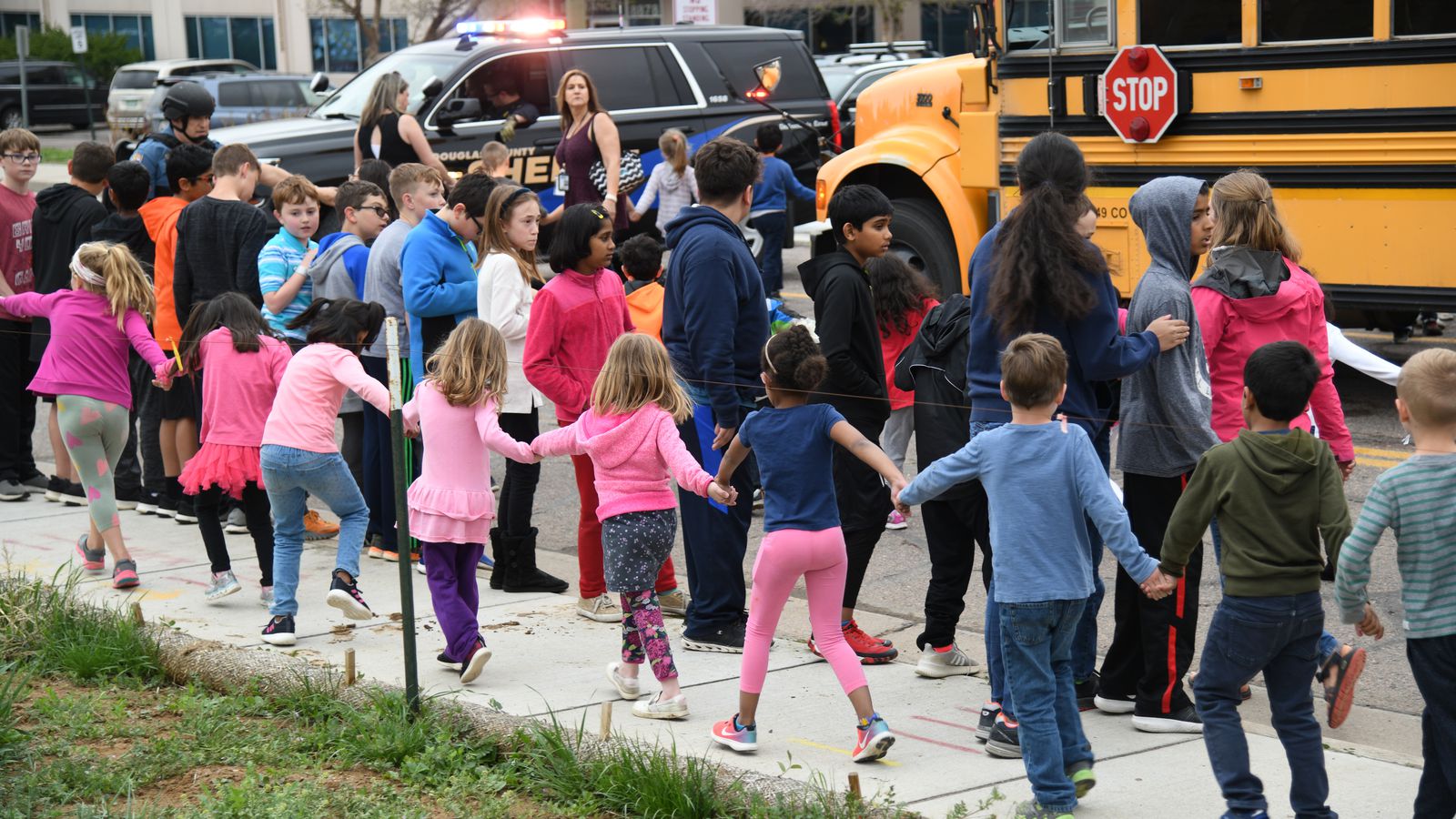Students escorted to a school bus at STEM School Highlands Ranch after the shooting. Photo: Hyoung Chang/MediaNews Group/The Denver Post via Getty Images
For some parents, their child’s back-to-school shopping list has expanded beyond crayons, glue, and pencils. With the increased frequency of mass shootings we’ve seen in 2018 and 2019, their shopping list is including bullet-resistant backpacks. Sales of bullet-resistant backpacks have increased by nearly 200% in the past two years.
This measure, among many others (e.g., arming teachers) advocated by lawmakers, will not stop school shootings. They are measures used after the gunfire has begun. We need a system or program that prevents a person of concern from entering a school with the intent to injure others. A lot of attention is being placed on gun control. I see this as an entirely separate issue. We need a system that will stop someone with a gun, knife, bomb, or club. I want to give you insight into how these tragic events are occurring and how we can stop them from ever happening in the first place.
I am a former member of a county-wide school threat assessment team. In 180 days of school, I performed 125 behavioral threat assessments. I train school staff and police officers all over the United States on how to identify an individual on a path to violence, determine their level of risk, and then how to manage them. The knowledge of how to identify concerning behavior is a skill everyone should have, not just police officers. I will share it with you here.
The first thing you need to know about people who have committed these violent acts in schools, workplaces, or in public areas is they didn’t just snap. They didn’t wake up one day and say, “I’m going to shoot everyone at my school.” They planned the attack, sometimes weeks, months, and in some cases, years in advance. We call this “targeted violence.” Their planning and preparation to achieve their violent goal had visible behaviors. If we know what these behaviors look like, we have a chance to interrupt these attacks from ever occurring. This is good news. We don’t have to buy our children bullet-resistant backpacks and pray we never get “that” call from the school. We can proactively make a difference.
Leakage
The first warning behavior that usually gets our attention is called “leakage.” Leakage is defined as “the communication to a third party of an intent to do harm to a target.” Leakage can occur through oral, written, or social media communications. Students might intentionally confide in a peer or communicate their violent plans through their journals or social media pages. In their study of school violence, the U.S. Secret Service and U.S. Department of Education noted that in 81% of the 37 violent incidents reviewed between 1974 and 2000, at least one individual knew the attacker was considering an act of violence before it transpired. These individuals were most often (93%) friends, classmates, or siblings; only rarely (17%) did the attackers threaten their intended targets directly. In this one pathway warning behavior, we have an amazing opportunity to stop an individual’s progression to violence. So, why aren’t people who are witnesses to leakage telling anyone? It can stem from people’s personal fear of “getting involved,” or perhaps they are not sure what to do or who to tell. Every police agency has adopted the “see something, say something” campaign. If you see inappropriate behavior, that may be a sign of leakage, do not keep it to yourself. Call your local police agency and report what you know. You can even do it anonymously.
Trust Your Gut and Tell Someone
Researchers also found that almost all the attackers (93%) engaged in behaviors that concerned others before the incident. The concerning behaviors of the attackers included the use of weapons (63%), fascination with violence displayed through class assignments or verbal communications (59%), and suicidal ideation (78%). The majority of the attackers had access to weapons before the incident (68%) and had a known history of weapon use (63%). If you get the feeling that something isn’t right, share your concerns with someone that can do something about it. That may be your school principal, school police officer, counselor, or local police. After a violent event like the 2019 Gilroy Garlic Festival shooting, people who knew the shooter are recounting story-after-story that clearly labeled him as a person of concern, but authorities never heard of him before.
How We Prevent the Next Shooting
I train schools, businesses, and law enforcement on how to conduct a behavioral threat assessment. Shockingly, most school districts and police departments do not have a threat assessment procedure or have people trained to assess a person of concern. If you want to stop a shooting at your school or place of business, do not invest in gun detectors, invest in training people detectors.
Every teacher and staff member at a school should be trained to identify pathway warning behaviors and how to report them. School police officers, school administrators, and counselors must be trained on how to perform a behavioral threat assessment. The threat doesn’t end at the assessment. They also need to be trained on how to manage a person of concern. Expelling a student from your school doesn’t put a magical forcefield around your campus. Marjory Stoneman Douglas High School learned this. After they expelled Nikolas Cruz the prior year, he returned and murdered 17 people.
After reading this article, sadly, you probably know more about behavioral threat assessments and identifying a potential school shooter than 90% of school officials and law enforcement. After working with schools all over the country, I have learned something very important. If you want something done, and you want change, it has to come from parents demanding it.
Parents should be asking their school district some difficult questions. Ask them, do you have a threat assessment procedure? When you identify a person of concern, what do you do? If the answer is, we call the police. Then the next question is, are they trained to assess a person of concern? What happens after the kid gets released from juvenile hall or the hospital? Do they have a plan to manage that kid? Is every teacher at your child’s school trained to identify pathway warning behaviors? Do they have a mandatory reporting procedure? If they have been trained, ask, are they retrained every year? If they’re not, they should be.
Share this article with your friends on social media. This needs to be a national conversation.
Training
Behavioral Threat Assessment and Management. In this 8-hour course, you will learn a threat assessment-intervention model that can be used by educators, law enforcement officers, mental health professionals, and others involved in school safety.
Active Shooter Prevention and Response Training. In this 3-hour block of training, your professional staff and employees will learn how to identify concerning behavior before it turns violent and how to respond to a violent intruder at your place of work.
Understanding and Preventing School Violence is a 90-minute, engaging, and eye-opening presentation about the causes of deadly school violence and the actionable steps parents and community members can take to prevent violence in their schools.
About the author
Clayton Cranford is a Sergeant in a Southern California law enforcement agency and owner of Total Safety Solutions LLC. Clayton is one of the nation’s leading law enforcement educators on social media, child safety, and behavioral threat assessments. Clayton is the author of the definitive book on cyber safety for families, “Parenting in the Digital World.” He has also authored several articles for the Journal of School Safety and wrote the National School Resources Officer’s manual on Internet safety and cyber crimes.
He has served as a member of the Orange County School Threat Assessment Team, School Resource Officer, and Crisis Negotiation Team. He has investigated threats, weapon possession, and violent crimes in K-12 schools throughout Orange County, California.
He created Cyber Safety Cop, a comprehensive Internet, and social media safety program. It teaches parents and students how to avoid online threats, such as cyberbullying, online predators, pornography, and social media addiction. Clayton was awarded the 2015 National Bullying Prevention Award from the School Safety Advocacy Council, and the 2015 American Legion Medal of Merit.





